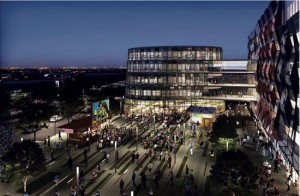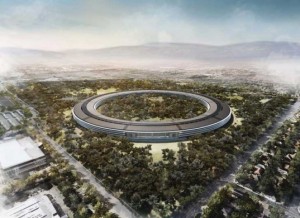For environmental and economic reasons, we want jobs and people to move back to our cities. People living in cities pollute less because they don’t drive as much and tend to live in smaller homes. Economically, they can save a lot of money on transportation and energy costs, while thriving neighborhoods can create cultural and economic hotspots with the innovation that comes from frequent and diverse human interactions.
The trends so far have been good for “infill” living: millennials find cities to be much more fun and convenient then the boring old suburb of yesteryear; baby boomers are moving out of cavernous suburban homes for exciting, walkable lifestyles in the city; and members of the fast-growing Latino community generally prefer more public, compact, and transit-oriented neighborhoods to the suburbs. The market has begun to respond, with building permit data revealing that infill has started to dominate over sprawl construction in the past decade.
But the backlash has begun, almost exclusively from residents of the neighborhoods that are most popular for infill living. As I blogged yesterday, on Tuesday night wealthy residents of Santa Monica successfully convinced their city councilmembers to rescind approval of a proposed office and housing complex around a future light rail station. The homeowners hired attorneys and funded a successful petition drive to challenge the approval. Residents there (my former home for eight years) are happy to benefit from a multi-billion dollar rail line but do not want new office workers and residents in their beach community. Worse, the decision to rescind the project could have a major chilling effect for transit-oriented developers across the Westside of Los Angeles, now that they know their projects can be killed at the last minute by well-resourced homeowner groups. Up north in San Francisco, residents of the Mission District neighborhood (also a former home of mine) received widespread media coverage for protesting the “Google bus,” one of many employer-sponsored private shuttles that take mostly young tech workers from San Francisco to the corporate mother ships in the Silicon Valley to the south. The Mission residents blame the buses for allowing these affluent tech workers to move into the neighborhood, drive up rents, and “change the character” of the place. In short, the fear is gentrification and loss of affordability. And along the San Francisco waterfront, wealthy homeowners in North Beach successfully launched a vote to block an upscale waterfront condominium from going in near the Embarcadero — an overwhelming ballot victory that scared the Golden State Warriors into moving their proposed arena far to the south to avoid more voter challenges. Meanwhile, in Silicon Valley to the south, upscale communities like Cupertino and Mountain View are happy to green-light new office complexes but won’t allow new housing, leading to a huge jobs-housing imbalance that forces everyone in the region to clog the roads and pollute the skies trying to get to work in the South Bay. Housing and rental prices have skyrocketed for everyone.These infill protest examples are diverse in nature but illustrate a larger concern for California’s future: if infill projects can be so easily shot down by neighbors, how are we going to accommodate a growing population without sprawling into economic and environmental misery?
California’s current land use laws and regulations disproportionately benefit existing residents over the broader interests of the region, not to mention future residents and generations. Local control over land use, citizen petitions, and the California Environmental Quality Act (CEQA) are all part of the problem. The state needs to rebalance power away from the wealthy and organized few and back in favor of the many — the workers forced into long, expensive commutes, the residents unable to afford rents or home prices, and the people who suffer from the public health and environmental impacts of our rudderless and uncoordinated land use decisions.
As a first step, communities that are not willing to accommodate new residents, or only accommodate jobs but not housing, should lose out on access to state and regional funds. If these cities and towns prefer to island themselves or become an economic and environmental drag on the region, they should shoulder the costs by themselves. SB 375 (Steinberg, 2008) took a step in this direction by prioritizing regional transportation funds to infill areas. But regional agencies should go farther, linking transportation dollars to specific land use metrics. As an example, Los Angeles taxpayers should consider rescinding payment for Santa Monica’s light rail station, since the community will not allow development there.
In addition, the state should consider adding qualifications to the constitutional power given to local voters to launch initiatives challenging local land use decisions. These citizen petitions have become a tool for well-funded interest groups, overturning badly needed projects and disproportionately benefiting the existing few over the many. Policy makers should require greater transparency on who is funding the signature drives, increase the number of signatures needed, and require votes to be held in November (when there is a greater, more representative turnout of the electorate).
Finally, California has taken a number of steps recently to improve and expedite environmental review of infill development near transit, given the significant environmental benefits that result from locating jobs and homes in these locations. The state should continue to push these efforts, reforming transportation impact analysis to remove auto delay as a factor, forcing disclosure of secret CEQA settlement agreements, and improving CEQA exemptions for projects consistent with specific plans.
These solutions would go a long way to ensuring that the much-needed infill movement is not strangled in its crib by homeowner groups. Business-as-usual development in California over the past half-century has resulted in a severe housing crunch, crushing traffic, lost open space, and significant environmental problems. We need solutions to match the scale of the problem, and we can’t ignore the risks posed by the growing backlash.
One thought on “California’s Infill Backlash — it’s here, and it needs to be addressed”
-
Pingback: Millennials Take On The Urban Housing Shortage | Ethan Elkind
Leave a Reply
You must be logged in to post a comment.





